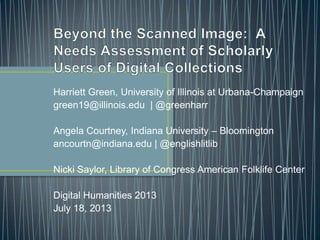This document summarizes findings from a multi-institutional study on how humanities scholars use digital collections in their research. The study involved a survey of faculty members in English, history, and fine arts from 15 universities. It found that while digital materials are increasingly important, scholars still value original sources when possible due to completeness and sensory experience. Common uses of digital materials included texts, images, and maps for research activities like topic modeling, comparisons over time, and assessing media representations. However, scholars desired improved searchability, annotation tools, and more complete collections to further support their work.






















